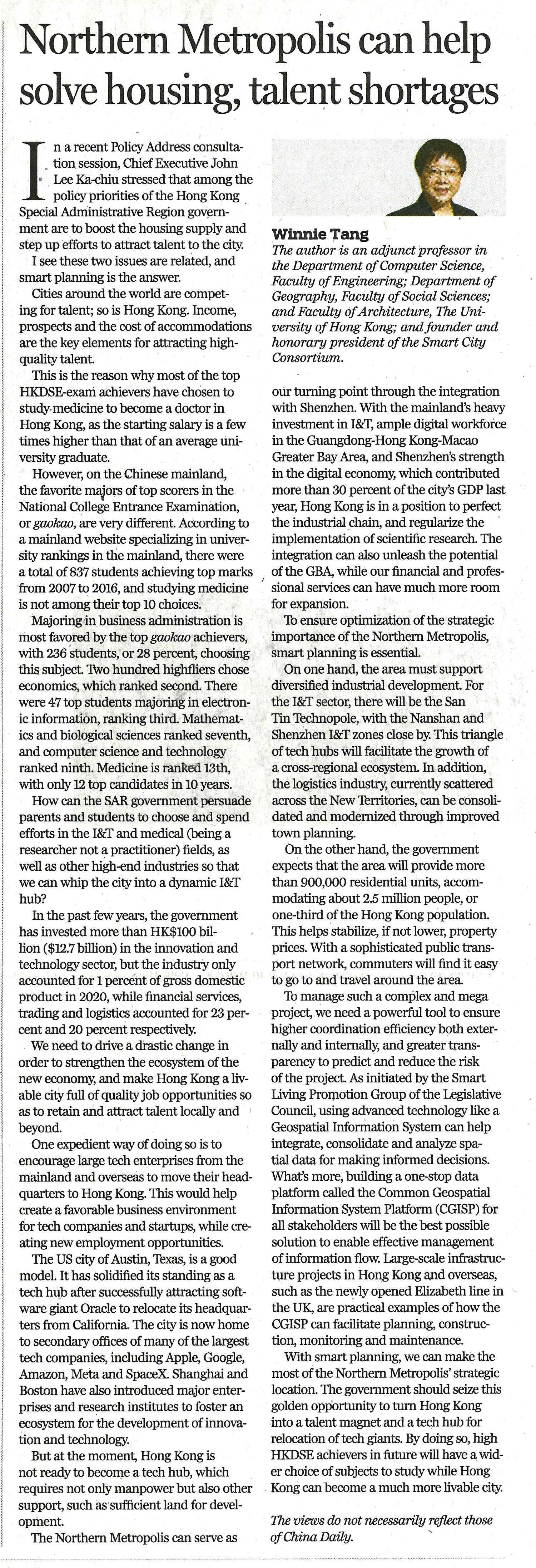網上版請按此

Northern Metropolis can help solve housing, talent shortages
In a recent Policy Address consultation session, Chief Executive John Lee Ka-chiu stressed that among the policy priorities of the Hong Kong Special Administrative Region government are to boost the housing supply and step up efforts to attract talent to the city.
I see these two issues are related, and smart planning is the answer.
Cities around the world are competing for talent; so is Hong Kong. Income, prospects and the cost of accommodations are the key elements for attracting high-quality talent.
This is the reason why most of the top HKDSE-exam achievers have chosen to study medicine to become a doctor in Hong Kong, as the starting salary is a few times higher than that of an average university graduate.
However, on the Chinese mainland, the favorite majors of top scorers in the National College Entrance Examination, or gaokao, are very different. According to a mainland website specializing in university rankings in the mainland, there were a total of 837 students achieving top marks from 2007 to 2016, and studying medicine is not among their top 10 choices.
Majoring in business administration is most favored by the top gaokao achievers, with 236 students, or 28 percent, choosing this subject. Two hundred highfliers chose economics, which ranked second. There were 47 top students majoring in electronic information, ranking third. Mathematics and biological sciences ranked seventh, and computer science and technology ranked ninth. Medicine is ranked 13th, with only 12 top candidates in 10 years.
How can the SAR government persuade parents and students to choose and spend efforts in the I&T and medical (being a researcher not a practitioner) fields, as well as other high-end industries so that we can whip the city into a dynamic I&T hub?
In the past few years, the government has invested more than HK$100 billion ($12.7 billion) in the innovation and technology sector, but the industry only accounted for 1 percent of gross domestic product in 2020, while financial services, trading and logistics accounted for 23 percent and 20 percent respectively.
We need to drive a drastic change in order to strengthen the ecosystem of the new economy, and make Hong Kong a livable city full of quality job opportunities so as to retain and attract talent locally and beyond.
One expedient way of doing so is to encourage large tech enterprises from the mainland and overseas to move their headquarters to Hong Kong. This would help create a favorable business environment for tech companies and startups, while creating new employment opportunities.
The US city of Austin, Texas, is a good model. It has solidified its standing as a tech hub after successfully attracting software giant Oracle to relocate its headquarters from California. The city is now home to secondary offices of many of the largest tech companies, including Apple, Google, Amazon, Meta and SpaceX. Shanghai and Boston have also introduced major enterprises and research institutes to foster an ecosystem for the development of innovation and technology.
But at the moment, Hong Kong is not ready to become a tech hub, which requires not only manpower but also other support, such as sufficient land for development.
The Northern Metropolis can serve as our turning point through the integration with Shenzhen. With the mainland's heavy investment in I&T, ample digital workforce in the Guangdong-Hong Kong-Macao Greater Bay Area, and Shenzhen's strength in the digital economy, which contributed more than 30 percent of the city's GDP last year, Hong Kong is in a position to perfect the industrial chain, and regularize the implementation of scientific research. The integration can also unleash the potential of the GBA, while our financial and professional services can have much more room for expansion.
To ensure optimization of the strategic importance of the Northern Metropolis, smart planning is essential.
On one hand, the area must support diversified industrial development. For the I&T sector, there will be the San Tin Technopole, with the Nanshan and Shenzhen I&T zones close by. This triangle of tech hubs will facilitate the growth of a cross-regional ecosystem. In addition, the logistics industry, currently scattered across the New Territories, can be consolidated and modernized through improved town planning.
On the other hand, the government expects that the area will provide more than 900,000 residential units, accommodating about 2.5 million people, or one-third of the Hong Kong population. This helps stabilize, if not lower, property prices. With a sophisticated public transport network, commuters will find it easy to go to and travel around the area.
To manage such a complex and mega project, we need a powerful tool to ensure higher coordination efficiency both externally and internally, and greater transparency to predict and reduce the risk of the project. As initiated by the Smart Living Promotion Group of the Legislative Council, using advanced technology like a Geographic Information System can help integrate, consolidate and analyze spatial data for making informed decisions. What's more, building a one-stop data platform called the Common Geospatial Information System Platform (CGISP) for all stakeholders will be the best possible solution to enable effective management of information flow. Large-scale infrastructure projects in Hong Kong and overseas, such as the newly opened Elizabeth line in the UK, are practical examples of how the CGISP can facilitate planning, construction, monitoring and maintenance.
With smart planning, we can make the most of the Northern Metropolis' strategic location. The government should seize this golden opportunity to turn Hong Kong into a talent magnet and a tech hub for relocation of tech giants. By doing so, high HKDSE achievers in future will have a wider choice of subjects to study while Hong Kong can become a much more livable city.
Dr. Winnie Tang
Adjunct Professor, Department of Computer Science, Faculty of Engineering; Department of Geography, Faculty of Social Sciences; and Faculty of Architecture, The University of Hong Kong